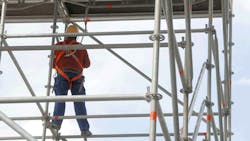Stricter Enforcement Results in Fall Protection Equipment Market Outpacing Economy
The low-to-moderate levels of compliance with EHS regulations have hindered the growth of the fall protection market in North America, according to a new study by Frost & Sullivan. However, with regulatory bodies such as OSHA cracking down on non-compliant companies, the market for fall protection equipment soon will accelerate. More stringent enforcement of safety regulations from OSHA, oil and gas commissions, the American National Standards Institute (ANSI) and the Canadian Standards Association (CSA) is expected to continue during the next 5 to 7 years.
Analysis from Frost & Sullivan, North American Fall Protection Equipment Market, finds that the market earned revenues of $453.7 million in 2010 and estimates this to reach $670.5 million in 2017, at a compound annual growth rate of 5.7 percent.
“Government regulators form industry standards across the North American fall protection equipment market by emphasizing the need for personnel working in an unprotected area to wear fall arrest equipment,” said an analyst from Frost & Sullivan. “As the legislation becomes more rigorous, the number of workers affected by the requirements will increase, giving a boost to equipment sales.”
Lack of Awareness
A lack of awareness among workers about different fall protection products and their application also considerably has restrained the market. To increase product acceptance, equipment companies should conduct marketing campaigns and strategies related to fall protection awareness.
Greater knowledge of safety regulations will prompt end-user companies to invest in additional fall protection products for the employees at risk of fall injuries. There is an increasing preference among end-users for first-hand expertise and single-source supply, along with greater demands for managed supply contracts or leasing arrangements, according to the survey.
“Innovation, proximity to end-users, investment in brand awareness and rational resources allocation, as well as new market and sector development are vital to succeed in the fall protection equipment market,” notes the analyst. “Novel technologies and improvements in ergonomics, comfort and convenience are expected to increase equipment reliability and use.”
An aging work force and obsolete infrastructure not only has intensified the requirement for fall protection, but also heightened the competition. Participants range from small companies focusing on a single type of equipment to large multinational corporations that manufacture and supply many types of sophisticated safety products.
Competition is at its most intense among independent domestic manufacturers that specialize in select segments. Safety products’ industry business cycles reflect a need to regularly replace products due to normal wear and tear or due to their one-time use design.
Overall, tighter governmental control, higher penalties for noncompliance and fear of liability will continue to drive the North American fall protection equipment market, according to Frost & Sullivan, which works in collaboration with clients to address global challenges and related growth opportunities.
About the Author

Sandy Smith
Sandy Smith is the former content director of EHS Today, and is currently the EHSQ content & community lead at Intelex Technologies Inc. She has written about occupational safety and health and environmental issues since 1990.
